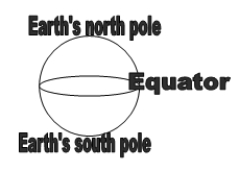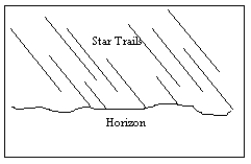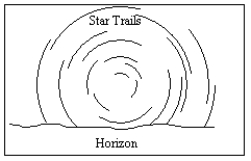Correct Answer

verified
Correct Answer
verified
Multiple Choice
A(n) ____ is 1/60th of a minute of arc.
A) precession
B) second of arc
C) degree
D) nadir
E) angular diameter
Correct Answer

verified
Correct Answer
verified
Multiple Choice
A sketch of the Earth with its north and south poles and equator is shown. The zenith is located in the sky over your head if you are at 
A) Earth's equator.
B) Earth's north pole.
C) Earth's south pole.
D) any of these.
Correct Answer

verified
Correct Answer
verified
Multiple Choice
If an observer walks north toward increasing latitude, the number of circumpolar stars would
A) remain constant.
B) decrease.
C) increase.
D) Unknown unless you also state the longitude of the observer.
Correct Answer

verified
Correct Answer
verified
Multiple Choice
The apparent visual magnitude of a star is a measure of the star's
A) size.
B) intensity.
C) distance.
D) color.
E) temperature.
Correct Answer

verified
Correct Answer
verified
Multiple Choice
How much of the night sky is north of the celestial equator?
A) less than one-half, because of the tilt of the equator to the ecliptic plane
B) more than one-half, because of the precession of the poles
C) exactly one-half
D) all of the night sky
Correct Answer

verified
Correct Answer
verified
Multiple Choice
An observer in the Southern Hemisphere takes a time exposure photograph of the night sky. If the illustration below depicts the photograph taken by the observer, which direction was the camera pointing? 
A) straight north
B) straight east
C) straight south
D) straight west
E) straight up, directly overhead
Correct Answer

verified
Correct Answer
verified
Short Answer
The ____________________ is the point on the celestial sphere directly above an observer, regardless of where the observer is located on Earth.
Correct Answer

verified
Correct Answer
verified
True/False
A second magnitude star in Ursa Major is brighter than a fourth magnitude star in Orion.
Correct Answer

verified
Correct Answer
verified
Multiple Choice
During one day and night in the mid-northern hemisphere, the stars near the north celestial pole
A) rise in the east.
B) set in the west.
C) circle the north celestial pole counter-clockwise.
D) circle the north celestial pole clockwise.
Correct Answer

verified
Correct Answer
verified
Short Answer
____________________ is a measure of the light energy that hits one square meter in one second.
Correct Answer

verified
Correct Answer
verified
Multiple Choice
An observer at Earth's geographic north pole would find _______
A) the celestial equator passing at 45 degrees above the northern horizon.
B) the celestial equator passing at 45 degrees above the southern horizon.
C) that the celestial equator coincides with the horizon.
D) the celestial equator passing directly overhead.
E) None of the above are true.
Correct Answer

verified
Correct Answer
verified
Multiple Choice
Table 2-1
 -Refer to Table 2-1. Based on the information in the table, what is the ratio of the intensity of Dra to that of Nim?
-Refer to Table 2-1. Based on the information in the table, what is the ratio of the intensity of Dra to that of Nim?
A) 2.512
B) 5
C) 8.07
D) 11.14
E) 100
Correct Answer

verified
Correct Answer
verified
Multiple Choice
A(n) ____ is 1/60th of a degree.
A) precession
B) second of arc
C) minute of arc
D) nadir
E) angular diameter
Correct Answer

verified
Correct Answer
verified
Multiple Choice
An observer in the Northern Hemisphere watches the sky for several hours. Due to the motion of Earth, this observer notices that the stars near the north celestial pole appear to move
A) counter-clockwise around the celestial pole.
B) clockwise around the celestial pole.
C) from left to right.
D) from right to left.
E) nearly vertically upward.
Correct Answer

verified
Correct Answer
verified
Multiple Choice
Seen from the northern latitudes, the star Polaris
A) is never above the horizon during the day.
B) always sets directly in the west.
C) is always above the northern horizon.
D) is never visible during the winter.
E) is the brightest star in the sky.
Correct Answer

verified
Correct Answer
verified
Multiple Choice
Stars in the same constellation
A) probably formed at the same time.
B) must be part of the same cluster of stars in space.
C) must have been discovered at about the same time at the same location in space.
D) may actually be very different distances away from the observer and from each other.
Correct Answer

verified
Correct Answer
verified
Multiple Choice
An observer on Earth's equator would find
A) Polaris directly overhead.
B) Polaris 40° above the northern horizon.
C) Polaris on the northern horizon.
D) that the celestial equator passing directly overhead.
E) that the ecliptic coincides with the horizon.
Correct Answer

verified
Correct Answer
verified
True/False
The constellation of Orion is currently visible in the evenings in January. Precession will not affect this and Orion will still be visible in January 13,000 years from now.
Correct Answer

verified
Correct Answer
verified
Multiple Choice
An observer in the Southern Hemisphere takes a time exposure photograph of the night sky. If the illustration below depicts the photograph taken by the observer, which direction was the camera pointing? 
A) straight north
B) straight east
C) straight south
D) straight west
E) straight up, directly overhead
Correct Answer

verified
Correct Answer
verified
Showing 61 - 80 of 80
Related Exams